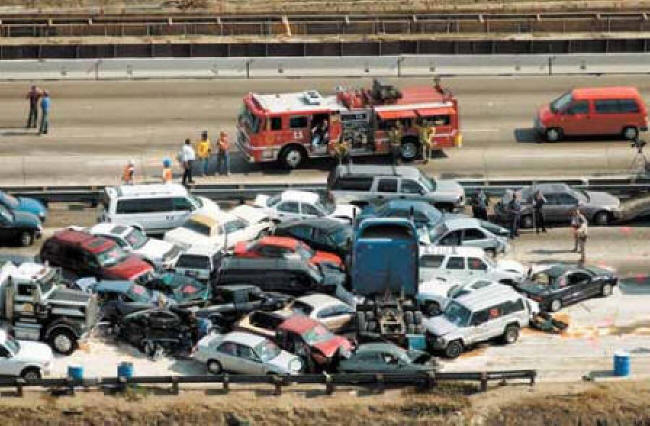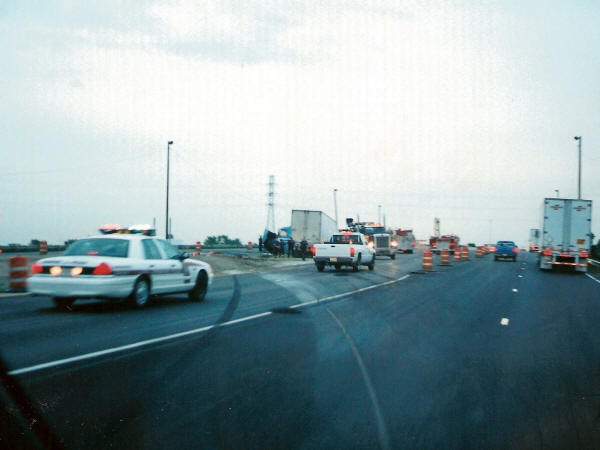|

Road Safety
|
|
Defensive Driving

The ultimate responsibility of safe driving under any
conditions or circumstances falls on the driver; no policy or procedural
statements can eliminate that responsibility.
To ensure road safety, drivers must be fully aware of and
abide by the laws, rules and regulations as set out by all government levels.
|
|
A good, safe, defensive driver is one who:
-
Knows and obeys the rules of the road.
-
Anticipates the mistakes of other drivers who may
lack skill, use poor judgment or make unsafe maneuvers, which could
jeopardize road safety.
-
Exercises care to avoid making any driving errors
of their own.
-
Has learned to drive proficiently in different
situations like highway or city driving, day and night driving, or driving
under various weather conditions.
-
Uses extra care to avoid being involved in an
accident or a close call due to weather, road conditions, traffic, or the
actions of pedestrians and other drivers.
-
Keeps windows and mirrors clean with mirrors
properly adjusted to provide the best possible view around the vehicle.

|
|
A good driver :
-
Is continually alert and watching for
accident-producing situations in advance where defensive action may be
required and is always prepared to react to the unexpected.
-
Knows how to safely take quick evasive actions in
emergency situations and can control the vehicle in the event of skidding,
tire blowout, mechanical failure, jackknife or other emergency situations.
-
Does not make erratic or unpredictable maneuvers
such as sudden lane changes which pose a serious safety risk.
-
Gives up the right of way in order to prevent the
risk of an accident.
-
Is well acquainted with the controls, features and
safe operation of the vehicle they are driving and exercise proper use of
lighting systems, windshield wipers, turn signals etc..
|
|
|

A good driver :
-
Is observant of other vehicles traveling into blind
spots and accounts for them in their driving behavior.
-
Avoids blind spots of other vehicles.
-
Accounts for wind conditions by reducing speed and
being prepared for sudden gusts which could push vehicle into another lane
or off the road.
-
Uses common sense when a vehicle is tailgating or
driving dangerously or aggressively, by changing lanes or pulling to the
side of the road if necessary if and when it is safe to do so using
appropriate signals and timing.
-
Drives at appropriate speeds for the weather,
traffic and road conditions.
-
Remains centered properly in traffic lanes using
appropriate signals and timing while changing lanes.
-
Is observant of construction or speed reduction
signs.
 |
|
A good driver :
-
Avoids drifting into “tunnel vision” or “highway
hypnosis” by continually looking ahead of and around the vehicle and
checking mirrors for other traffic.
-
Recognizes that road features such as
intersections, curves, hillcrests, bridges, railroad crossings and tunnels
generate increased hazards and exercises the care necessary in negotiating
these features to avoid creating an accident risk environment.
-
Is fully aware of the track of the vehicle and
exercises proper control while negotiating curves and turns to avoid running
over curb, damaging signs, light standards or cutting off or damaging other
vehicles.
-
Is cautious of bicyclists or children playing
anywhere near the roadway.
-
Allows ample space between vehicles of at least a
three second interval (more if any adverse conditions exist) to provide safe
reaction time.
-
Is observant while approaching and passing
crosswalks or when driving in the vicinity of playgrounds, schoolyards, and
parking lots.

A good driver :
-
Is alert to the increased hazards involved when
performing such maneuvers as backing, passing, changing lanes, parking and
leaving a parked position, and taking the appropriate actions required to
prevent the risk of an accident.
-
Uses extra caution when traveling in unfamiliar
areas.
-
Recognizes when road or weather conditions are
becoming unsafe and locates a safe place to park until conditions improve
enough to continue.
-
Exhibits proper use of four-way flashers, slow
vehicle sign, oversize load sign, oversize flashers, oversize flags,
“hazmat” placards, road flares, reflective triangles or any other warning
devices that are appropriate.
-
Maintains appropriate speed and gear selection when
navigating hills or mountainous areas.
-
Exhibits proper use of passing lanes or “turn out
areas” allowing faster traffic to pass on narrow roads or while climbing a
grade.
|
|
DRIVE SAFE! |
|
Privacy Policy
© 2002-2013 ezee.ca |
|